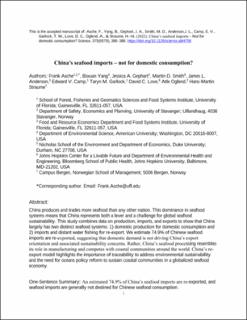China’s seafood imports – not for domestic consumption?
Asche, Frank; Yang, Bixuan; Gephart, Jessica A.; Smith, Martin D.; Anderson, James L.; Camp, Edward V.; Garlock, Taryn; Love, David C.; Oglend, Atle; Straume, Hans-Martin
Journal article, Peer reviewed
Accepted version
Permanent lenke
https://hdl.handle.net/11250/3091976Utgivelsesdato
2022Metadata
Vis full innførselSamlinger
Sammendrag
Global trade in seafood is tightly coupled with environmental, economic, and social sustainability (1–3). Yet, two features of global seafood trade hamper efforts to promote sustainability. First, the recent practice of importing seafood, processing it, and then exporting it (“reexporting”) at a large scale complicates tracing seafood from the water to the plate and enables mislabeling (4). Second, reexports can exacerbate problems stemming from distant-water fishing (DWF), i.e., fish caught in international waters and other countries’ economic zones. DWF obscures the distinction between domestic and imported seafood and is implicated in illegal, unreported, and unregulated (IUU) fishing and other unsustainable practices (5). Both features highlight the critical role of China (5, 6), the world’s largest DWF nation and largest seafood producer, consumer, exporter, and importer (by volume). Contradicting the narrative that Chinese domestic demand is driving imports, we estimate that 74.9% of imports to China are processed and reexported.
